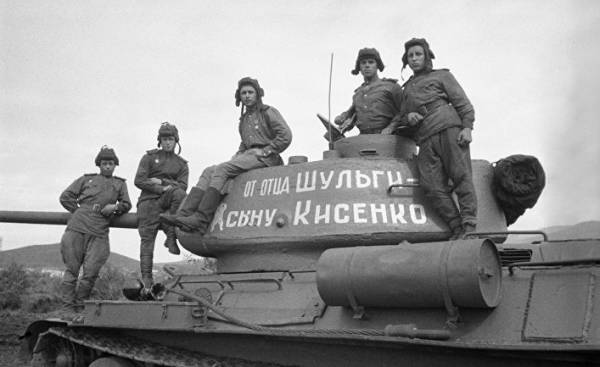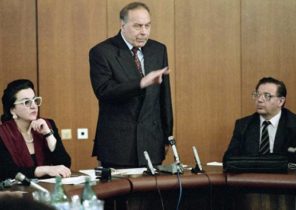
Final verdict the T-34 tank — less nice than the legend, which was created and distributed Tips. Nevertheless, it is very flattering and commendable. The t-34 changed the balance of power in favor of the USSR when it came to tank battles, and with its mass production, the Russian far exceeded Germany.
Determined Soviet tank crews in their T-34 defeated the Germans at Kursk. It was the greatest tank battle in history.
T-34 “was undoubtedly revolutionary, but he was not the first in anything, except that it found its combination of sloping armor, diesel engine, wide tracks and a fairly powerful gun of large caliber,” said Belkort. “All this was done before, but never together”.
On 22 June 1941, Nazi Germany launched operation “Barbarossa”, causing a massive blow to the Soviet Union. It was the largest invasion in history.
More than three million German soldiers, 150 divisions, and three thousand tanks were combined into a giant group of armies, which created a front with a total length of more than 2 900 miles.
The Germans were counting on the impact with the weaker than themselves, the enemy. Intoxicated with the victories in Poland and France, Hitler and many of his generals believed that Germany’s destiny is predetermined by the attack on Russia. “The end of Jewish rule in Russia will also be the end of Russia as a state,” announced Hitler, in his Manifesto Mein Kampf.
Months, the Germans have scored one great victory after another. But suddenly, the offensive stalled, and the appearance of the front of the new Soviet tank stunned the Wehrmacht.
It was a T-34 tank. The new armored car was an excellent 76-millimeter gun and thick sloping armor. He developed a speed of over 55 miles per hour. T-34 had many constructive advantages of the time and could have sent German tanks to hell.
The T-34 had its own problems, which we often forget to mention a tank with a legendary reputation. The disadvantages of T-34 include a limited review of the crew and low Soviet quality of work.
“They were good, but were not some miracle weapon, and they had their flaws, writes Philip Kaplan (Philip Kaplan) in his book “Crashing thunder: a century of tank war” (Rolling Thunder: A Century of Tank Warfare). But despite all its shortcomings, the tank experts and historians today often called T-34 best tank of the war.”
German field Marshal during world war II Ewald von Kleist (Ewald Von Kleist) put it more briefly, calling the T-34 the “best tank in the world”.
The origin of the T-34 is quite simple. The red Army had to find a replacement for my light tank BT-7, which possessed high speed and light armor, and was intended to conduct maneuver warfare. He also had Christie suspension, which allowed the tank to increase speed.
But during the border war with Japan in 1938-1939, this tank proved to be far from the best way. Japanese tanks-type 95, even with its less powerful cannon easily destroyed the BT-7. Fighters anti-tank units were also set on fire BT-7 bottles with an incendiary mix, turning them into flaming torches, because the gasoline seeped through the cracks in a poorly welded armour and into the engine compartment.
Problem solved T-34. He is survived by Christie suspension, but the gasoline engine was replaced by diesel 12-cylinder power plant V-2-34. She let the T-34 can reach speeds of 16 kilometers higher than the German machines “Panther III” and “Panther IV”.
In addition, the gun with high muzzle velocity, could hit any tank at the time.
“When Hitler in 1941 launched the “Barbarossa”, the T-34 was undoubtedly the best tank in the world — told the publication War Is Boring U.S. army tank commander Jason Belkort (Jason Belcourt). — A combination of sloped armor, powerful gun, good speed and agility he had surpassed all that at the time had the Germans”.
By mid-1941, the USSR had 22 thousand tanks — more than all the armies of the world combined, and four times more than what was available in the German Arsenal.
By the end of the war, the Soviet Union produced almost 60 thousand T-34 tanks, proving that the number itself becomes quality.
At first, the Germans were confused when they had to face in battle with tanks T-34. Before they are armed with anti-tank gun Kwk 36 caliber 37 mm and 50 mm Kwk 38 could not penetrate the frontal armor of the Soviet machine.
Therefore, variants of tactical actions, the Germans were little. German tank crews could shoot in the side armor of T-34. The Wehrmacht was able to establish minefields. Soldiers risked their lives, using backpack explosive charges and Molotov cocktails.
A kind of act of desperation was the fact that the Germans have modified their 88-millimeter anti-aircraft cannon to stop the attacking T-34 line-of-sight.
However, Russian is not always enough well-trained crews for those tanks that have adopted the Red army. The Soviets lost T-34 and their crews in large quantities.
By the time when the Soviets had trained a sufficient number of crews to man their tanks, the Germans have a powerful gun and improved antitank weapons like a grenade launcher “Panzerfaust” with shaped-charge warhead.
However, the Russians always had more T-34 than the Germans “Panther” and “Tigers”.
“Decisive in this case was the production battle, said Belkort. From June 1941 until the end of the war the Soviets have consistently made tanks, which were often good and always meet the requirements”.
The final verdict of the T-34 is less glorious than the legend, which was created and distributed Tips. Nevertheless, it is very flattering and commendable. The t-34 changed the balance of power in favor of the USSR when it came to tank battles, and with its mass production, the Russian far exceeded Germany.
Determined Soviet tank crews in their T-34 defeated the Germans at Kursk. It was the greatest tank battle in history.
T-34 “was undoubtedly revolutionary, but he was not the first in anything, except that it found its combination of sloping armor, diesel engine, wide tracks and a fairly powerful gun of large caliber,” said Belkort. “All this was done before, but never together”.







